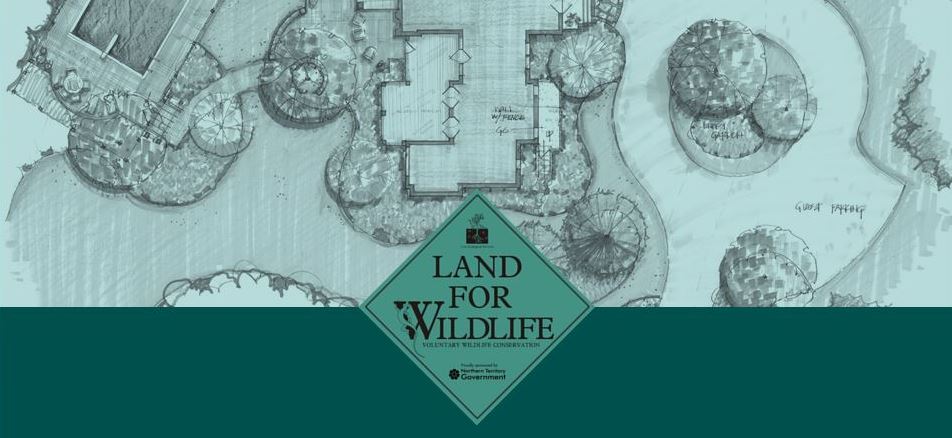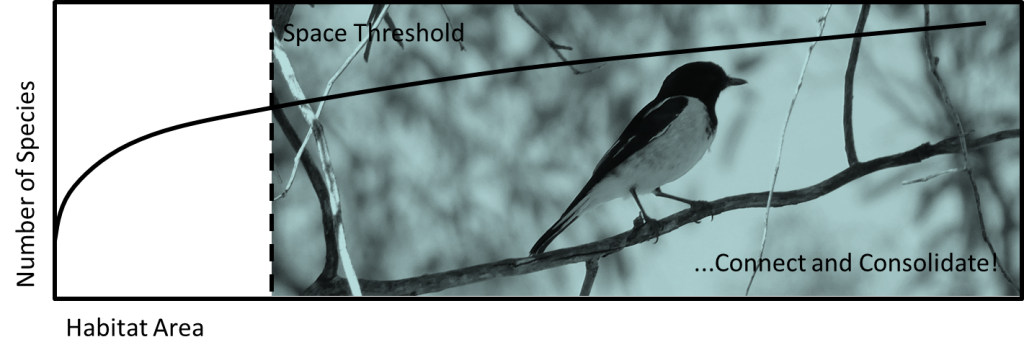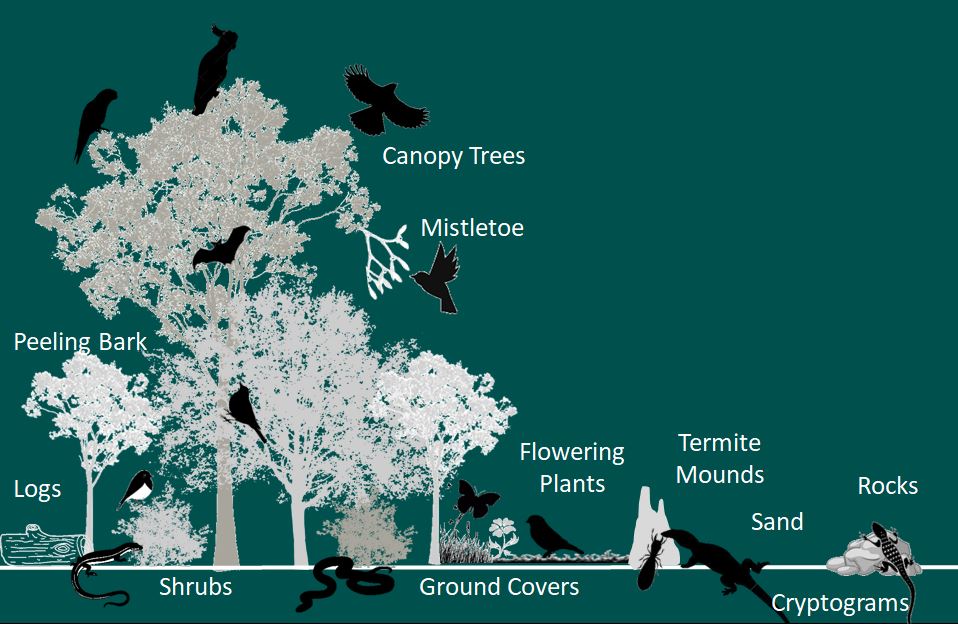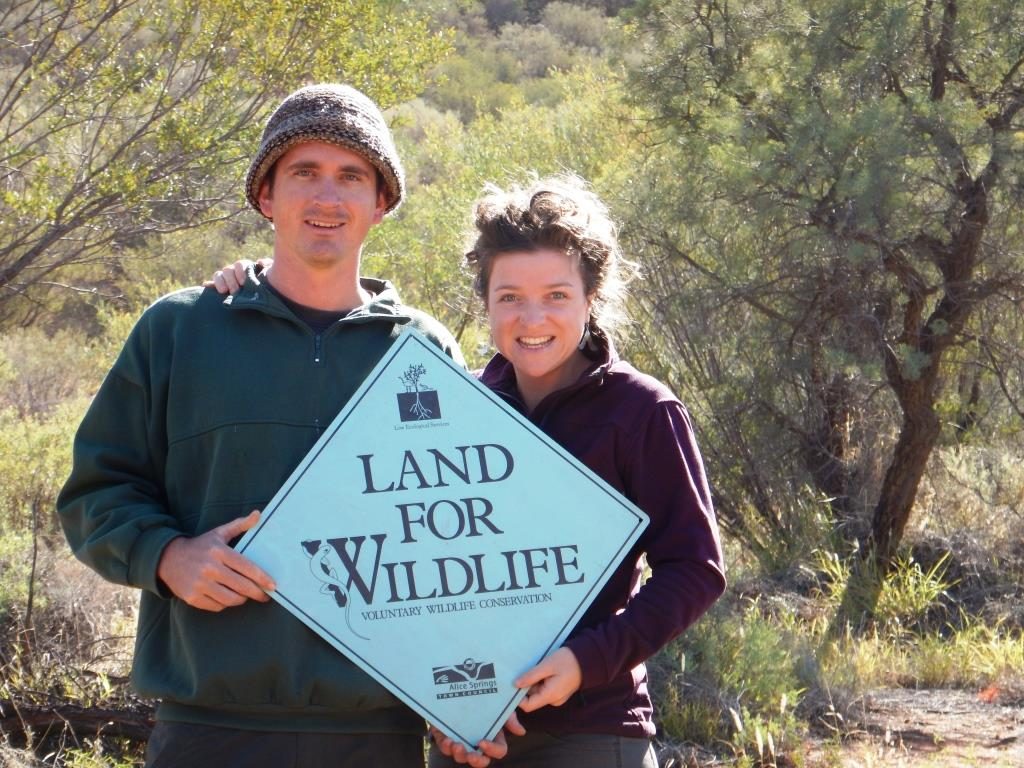We all love the plants, animals and other aspects of the natural world that we are surrounded with and want to learn how to protect them – the best that we can. You can aim as high as you like – or as humble as you like. Just do what you can. At the basic level, it could mean increasing your own awareness of wildlife and its needs. At a moderate level, it could mean installing a bird bath and providing fresh water to those in need and removing a few weeds. At the upper level, it could mean planting out your property and designing it in a way that maximises wildlife habitat.
The environment has been changed drastically with European arrival and increasing population levels. Much of the remnant vegetation has been cleared for agriculture, housing and infrastructure. In addition to habitat loss, there are many species that were introduced that subsequently became pests, causing enormous environmental and economic loss. Such species include rabbits, cats and foxes. At an invertebrate level, the European Honeybee, while providing economic benefit for pollination of crops, is a threat to native pollinators and ecosystems. The extreme changes to the environment have resulted in severe species loss, with 1 bird and 11 mammals having become extinct in the Northern Territory. In addition to the loss of fauna species, we are also experiencing a loss of plant species and erosion problems.
But it’s not all doom and gloom. With advances in research, we have come to understand the unique qualities of our native flora and fauna and the ecosystems of which they are a part. Wildlife is an asset that we should strive to retain. Landscape planning is important for flora and fauna considerations. In addition, biodiversity is important at many levels economically – environmental restoration, ecotourism, bush food cultivation, carbon credits, plant propagation and provision to the public, parks/reserves, environmental education to schools… and the list goes on!
Rural communities play an important role in protecting and rehabilitating the environment through groups such as Landcare, Land for Wildlife and other community based programs. Many parcels of land are locked up in pastoral leases, residential freehold and crown land. Remnant vegetation is often only visible on roadside verges and uninhabitable hillsides. As a result, National Parks are often preserving the extremes – ranges, gorges, valleys. The flat and degraded landscapes are often overlooked and require private landholders to get involved, especially if the land includes precious remnant habitat.
3 R’s – The priority for conserving flora is to Retain remnant vegetation, Restore the quality of degraded habitats, and Revegetate cleared areas.
There are a few general considerations when it comes to property planning for wildlife, including integration of land uses, time, space and species thresholds, and quality the habitat available.
Integration of land uses
Ensure you are meeting all your needs with respect to land use. Do you need space for working outdoors? Relaxation spaces? Active spaces for sport? Cover your needs and work with the rest.
Time
Time is required for habitats to develop, for pioneer species to be replaced by those of older stages, and for trees to develop hollows. Plan and be patient.
Quantity and Space Thresholds: Connect and Consolidate
The bigger the better! Larger and more compact areas support a greater diversity of habitats on different land systems, more species due to quantity and diversity of resources (see the species to area relationship), larger populations, and a greater chance of linkages between habitats. A space threshold is the minimum area required for a certain species to establish. If you are targeting selected species, ensure that you have the space required to support it before dedicating planting and planning activities towards it. For example, the Hooded Robin requires a territory of around 5 hectares, so many rural blocks may not be sufficient in their own right. Remember, getting your neighbours involved helps to widen the habitat corridor and larger patches are achievable with coordinated efforts. Complex large patches are integral during drought, as many bird species congregate in resource-rich sites in poor conditions, known as drought refuges.
For vegetation, compact areas are important as there is a greater core area away from edge disturbance (weeds, predators, surrounding land use). In the undergrowth, there are usually more weeds around edges, so smaller forbs and native grasses are likely to thrive in the core area of a larger patch. For larger trees, there is often more Mistletoe found in trees around edges that can put stress on large trees. Many species of fauna avoid edges due to the risk of predation and prefer core areas that provide safety. Yellow-throated Miners may dominate in linear patches of habitat and out-compete other smaller White-plumed Honeyeaters, Babblers etc, that prefer to take safety in core areas. Having some larger core areas will enable the wildlife to reach a balance.
On the other hand, edges offer a greater variety of resources for some fauna species that are able to utilise the adjacent habitats equally and can result in greater species diversity. For example, Kangaroos benefit from edges as they can take protection in woodlands and graze in open paddocks and dusk and dawn. The aforementioned Mistletoe, common around edges, is also necessary. It is native and has a symbiotic relationship with native Mistletoe Birds and the Spiny-cheeked Honeyeater, so don’t be hasty to remove it.
To help alleviate the effect of edges on remnant habitat, start by increasing the core area by undertaking revegetation activities around narrow areas. You may also wish to separate two differing and incompatible land uses with an intermediate complementary land use – a buffer. For example, if a portion of your property is being used for livestock and an adjacent patch of remnant vegetation has a significant edge, consider planting alongside the edge with an intermediate habitat to lessen the edge effect.
There is an increased risk of impact from random events in small and isolated patches, and limitations on dispersal of wildlife may be an issue. Therefore, if you have several small patches of habitat and no opportunity to expand them in size, you may wish to consider connecting the patches with wildlife corridors or stepping stones. Connected habitats protect area-limited and dispersal-limited species by providing an avenue for secure movement.
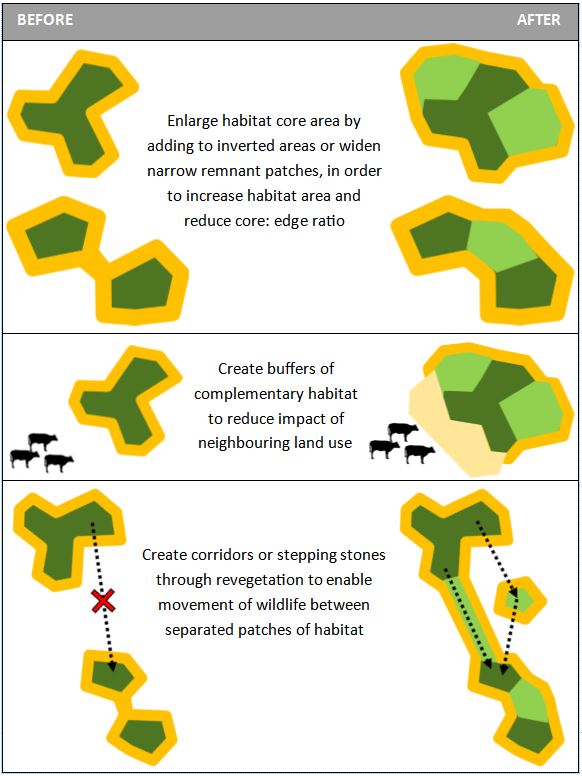
How much you can achieve will depend on how large your property is. If you have the time, space and resources – aim high! If you have a small area and are unable to increase patch size, you can adopt alternative management strategies such as restoring cover and connectivity to improve habitat for various species. Start with realistic goals, you can always expand if time and space allows it.
Quality
The quality of the habitat, the degree of degradation, and how well it functions are all important aspects to consider. So once the major aspects have been thought through, you can make your way down to the nitty gritty. What are you aiming for? For many, a generally healthy ecosystem is the goal. A healthy habitat is one in which most of the layers of vegetation are present and dominated by native plant species typical of the region. It is also a system that is free from disturbance, including introduced weeds and feral animals. High ecosystem function includes adequate pollination of flowering plants by native invertebrates and birds, natural wood decay for recycling of nutrients and provision of nesting hollows, as well as the presence of breeding populations of living organisms native to the area.
Vegetation Layers and Habitat Diversity
Adding layers of complexity in the garden increases the diversity of life that uses it as habitat. At a large scale, complexity can be in the form of different habitat types such as woodlands (many bird species), grasslands (Zebra Finch), creek lines (Kingfisher, Frogs, Fish), caves (Bats), gullies (Frogs), and hillsides (Euros, Wallabies).
Most species are highly dependent on water availability and quality so ensure you include water courses in your plan where possible. Protect existing watercourses and avoid modifying them to allow them to remain natural. If degraded, consider revegetating with native plants to prevent erosion, enhance wildlife habitat and encourage healthy water. In areas that don’t have natural water courses, you may consider installing a bird bath that can provide a water source. A bird bath that is raised above the ground and abutting shrubbery on one side will protect small birds from predators. Ponds are also suitable water sources for reptiles and frogs. Water baths can be topped up manually, or via a drip irrigation system as part of the whole garden. Install water tanks and a method of catching excess rain water to make the most of the water available.
Within a habitat type, complexity includes the provision of large canopy trees (Parrots, birds of prey) with tree hollows (Red-tailed Black Cockatoo, Bats) and loose hanging bark (Shrike Tit), complemented by a protective understorey (Rufous Whistler, Robins), ground cover, herbs, grasses and soil-crusting cryptograms. For example, a minimum of 30% tree cover is needed to maintain woodland birds. Smaller bird species are not as abundant in areas with little understorey, rather such open and scattered habitats favour the more aggressive Yellow-throated Miners. Healthy habitats include flowering trees and shrubs to support native pollinators (Honeyeaters, Invertebrates) and Mistletoe (Mistletoe Bird, Spiny-cheeked Honeyeater), and provides logs (Treecreepers, Reptiles), termite mounds (Perentie), rocky areas (Reptiles, Frogs), sandy areas (Snakes, Goannas), and mulch or groundcover (Reptiles, Invertebrates).
In terms of structure, the complexity of a habitat should provide breeding and sheltering sites, foraging sites, basking and hibernation sites, perching sites, runaways and refuges, camouflage, nurseries, and leaf-litter traps.
Native Plants
In Alice Springs, there are more than 600 native plant species, distributed over 27 individual vegetation types (as classified by Albrecht and Pitts in 2004). The vegetation present at a particular site is a result of regional and landscape factors such as rainfall, temperature, altitude, and topography; local factors such as soil type, geology, slope, aspect, and prevailing weather; individual factors such as environmental tolerance; and historical factors such as fire, disease, human impact, evolution, and species introductions. Local native species are best suited for revegetation activities as the wildlife has coevolved with the plant life – they often rely on each other for survival.
In arid Australia, it’s important to conserve water. You can do this by planting wisely. Local native plant species require less water than introduced species and lawns once established. Native plants are also hardy, giving you ‘bang for your buck’.
Be sure you keep updated about when the plant sales are on and what to buy – get in early to avoid missing out on the appropriate plants of your choice. Consider propagating your own plants to save money if revegetating large areas. This requires good timing and patience, as many native plants take many years to establish. If planting young individuals, choose your timing to avoid hot days and stress to plants, avoid planting before going on holidays or have a house-sitter that can look after them.
Plant wisely – use local native species where possible, account for growth of tree roots and canopy size (some species may interfere with each other or disrupt infrastructure), avoid lawns (they are water thirsty and don’t really add to the biodiversity – consider Lippia or Creeping Boobialla as an alternative), consider irrigation planning before planting (applies water where it is specifically needed, reduces water loss through evaporation, and encourages deep root growth). It’s a good idea to include wattles (Acacia sp.) in your planting plan for their nitrogen fixing abilities.
Free from Disturbance
Weeds and feral animals can have a serious impact on native flora and fauna populations. Invasive species often out-compete native species for resources, thereby reducing their chance of survival. The removal of Buffel Grass (not a declared weed) will often result in the reestablishment of a host of native forbs and grasses that act as a food source for native wildlife. Purchase plants, soil and mulch from local retailers to minimise the introduction of weeds. Protect seedlings from rabbits and other herbivores with guards and protect seedlings from water loss with mulch. Remove feral species such as Cats and Spotted Turtle-doves with an active and ethical trapping program. The establishment of feral and pest bird populations can be prevented by enclosing chicken feeders to eliminate access to seed.
Wood Decay
Natural and termite-induced wood decay is important for recycling of nutrients and provision of nesting hollows. Avoid pruning dying branches if safe to do so to ensure adequate perching sites and to allow decay, in turn providing habitat and nesting hollows for diversity of bat, insect and avian species. Leaving fallen branches to decay naturally will not only provide habitat for native reptiles and invertebrates, but allow Termites to feed and recycle nutrients back into the system.
A Healthy System
Successful pollination of flowering plants by native invertebrates and nectarivorous birds will enable plants to come into fruit and seed and therefore self-generate in the system. Some seed can then be collected for propagation, and the rest allowed to fall and natural regeneration to occur.
The presence of breeding populations of living organisms native to the area is indicative of a healthy working ecosystem.
Help the Needy
It’s important to protect threatened fauna species and their habitats where possible. To do this, you need to know where individuals occur and what habitat they require. Resources for this include Fauna Atlas records on NR Maps and the Atlas of Living Australia, as well as the NT Government Threatened Animals and Threatened Plants pages.
The NT Register of Significant Trees has a list of some of the territory’s most significant trees, but access to AAPA can also highlight other culturally significant trees or sites that are worthy of protecting.
Summary: Make a Plan
Begin by mapping or drawing your house and block. Google Earth, Google Maps and NR Maps can help you to get an idea of the shape and layout of your property.
Identify any significant sites that need protection.
Where are the water courses and wetlands?
Identify the remnant habitat patches. Which ones can be expanded?
What is the distance between healthy patches? Where can stepping stones and corridors be placed to increase connectivity? Where can buffers be placed to reduce effects of surrounding land use?
Improve the quality of degraded vegetation. Enlarge, widen or create linkages?
Revegetate areas of concern with local native species, including endangered species where possible
What is the percentage cover as it stands? How much do you want to add and where? Plan ahead to avoid overcrowding and competition for resources.
Are the needs of the desired wildlife species being met? How can this be improved?
Consider smart fencing – allow for movement by wildlife.
Encourage Others
Display your Land for Wildlife or Garden for Wildlife sign – this shows others in the area of your commitment to wildlife habitat preservation and restoration and helps to encourage others to follow your lead. This in turn creates a vegetation corridor or network of properties for wildlife to move between.
This workshop was supported by Territory Natural Resource Management with funding from the National Landcare Programme.
